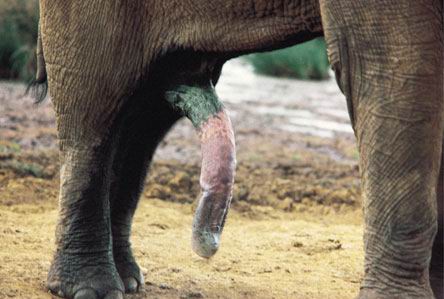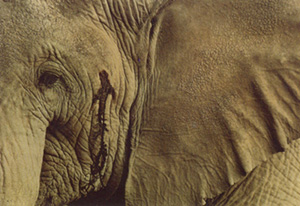Green Penis Syndrome In African Elephants
Posted: June 23, 2012 Filed under: Animal Penises | Tags: africa, elephants, gps, green penis syndrome, lsd-induced-death, musth, penis 2 CommentsWow. OK. So it seems my latest article on the gorilla’s penis has upset my esteemed colleague Brody J. Dickworth. Hopefully this means he has said his piece about his piece, but I very much doubt it.
Incidentally, Brody made a bizarre passing reference to elephants which reminds me of some interesting penis science worth relating here, if only to distance this majestic animal from its recent association with my colleague’s genitals.
At this point you might expect me to launch into my typical erudite exposition on the facts of the elephant penis: that it’s typically about 4 ft long, it bends in a S-shape when erect, and that it is able to writhe about independent from the elephant’s body because of special musculature (Short 1967). Well, dear reader, excuse me while I stifle a yawn.

Descriptive accounts of penises are all well and good–necessary even, as they are often the first step towards true penis science–but to focus solely on anatomy and physiology overlooks the larger aims of penis science, namely: 1) to give an evolutionary account of penises, i.e. the why and not just the how of a specific penis, 2) to understand the penis’s role in reproductive and social behavior, and 3) explore ways to improve our own penises.
Thus far this blog has mostly been concerned with the first aim, such as in the echidna penis article, and we’ve touched on the third aim in the barbed penis article. But today I would like to explore second aim, by way of the African elephant and the strange phenomenon known as green penis syndrome.
Green penis syndrome (GPS) in the African elephant was first documented by preeminent elephant biologist Cynthia Moss and her protégé Joyce Poole in 1976 during a research stint at Amboseli National Park in southern Kenya. Their memoirs (Poole 1996, Moss 1988) recount the tale…
One cool March morning, as the first light of dawn cast a touch of pink on the western snows of Mt. Kilimanjaro and as a dry wind blew across the Amboseli plains swirling dust raised by the massive gray columns treading slowly, deliberately, but nearly silent among the ancient acacia trees, Moss and Poole noticed an elephant with a slimy green penis. The bull was familiar to them, having seen him a day before when he was dribbling urine all over the Amboseli savanna. Today he still dribbled away, but now, alarmingly, there was also green pus coming out of the opening of his penile sheath and the penis itself. With a touch of cruelty, the researchers decided to call him “Green Penis”.
Days later they spotted Green Penis again and by this point Moss recounts that “his sheath had turned a greenish-white color, and gave off a very sharp, pungent odor, which was not unpleasant, but very strong,” and nearly one-third of his penis had turned green. They also noticed the sides of his face were stained with sticky brown secretions from the temporal glands. These secretions had been observed in African elephants before, but their purpose was a mystery to African elephant biologists. Despite these afflictions, Green Penis began to show interest in an estrous female, and after summoning a giant mint-green erection he followed her into a small grove of trees to mate.
Initially Moss and Poole thought Green Penis’s green penis was a symptom of a venereal disease, and they feared an epidemic. We may forgive them for this erroneous assumption, since as women they might not be familiar with the typical symptoms of STI’s in males (I doubt anyone would describe the smell of gonorrheal discharge as “not unpleasant”). But after more field observations, they soon realized that GPS was relatively common among post-pubescent male elephants, occurring annually and in conjunction with urine dribbling, temporal secretions, heightened aggression, and increased sexual activity. A male in this state was irresistable to a female–just a hint of that heady mixture of GPS and musky urine in the breeze could create a stir of excitement among female herds, even when the male was miles away. Eventually Moss and Poole had to concede that GPS was no disease, but an essential reproductive signal.
Moss and Poole were finally able to make sense out of these strange symptoms when they came across an article about Asian elephants showing the same urine dribbling and temporal secretions they were seeing in Green Penis and the other male African elephants. The article was on musth in male Asian elephants, a sort of temporary madness in which normally tame male elephants run berserk for about a period of two weeks, analogous to rutting behavior in deer and other ungulates.*
What Moss and Poole had discovered was that the phenomenon of musth must be present in the African elephant as well (Poole and Moss 1981). Earlier biologists had dismissed this possibility because musth in Asian elephants was always linked with temporal secretions, whereas in African elephants these secretions can occur outside of musth, too. But as is typically the case, a careful study the penis settled the confusion, leading the way like a big slimy beacon of scientific truth.
Let this be a lesson to the larger scientific community: penis science is to be taken seriously. We are not just a niche field filled with myopic pedants, like the taxonomists. No. Many of the breakthroughs in other more “respectable” disciplines begin with the penis, as Moss and Poole have shown.
But let this also be a lesson to penis scientists: we need to go beyond our anatomical and mechanical descriptions of penises, our urges to just draw, photograph, measure, and weigh. That’s not enough anymore. We need to put the penis in context–the evolutionary, behavioral, and moral contexts–otherwise we risk losing our relevance to the scientific community at large.
Footnotes
*In the care-free swinging 1960’s, scientists even tried to artificially induce musth by administering LSD to a male Asian elephant (West et al. 1962). The test subject, Tusko, promptly died.
References
Moss, C. J. 1988. Elephant Memories: Thirteen Years in the Life of an Elephant Family. The University of Chicago Press, Chicago.
Poole J. H. & Moss, C. J. 1981. Musth in the African elephant, Loxodonta africana. Nature: 292, 830-831.
Poole, J. H. 1996. Coming of Age with Elephants: A Memoir. Hyperion.
Short, R.V., Mann, T., Hay, M. F. 1967. Male Reproductive Organs of the African Elephant, Loxodonta africana. J Reprod Fertil: 13, 517-536.
West, L.J., Pierce, C.M., Thomas, W.D. 1962. Lysergic Acid Diethylamide: Its Effects on a Male Asiatic Elephant. Science: 138 (3545), 1100-1103.



Wow ! Very useful information, i must say i never knew this.
Keep up the gooa work.
[…] […]